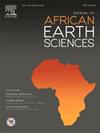刚果(布)北部古新生代森贝-韦索盆地的地质新发现--对基巴兰造山运动、新新生代断裂和泛非洲覆盖的影响
IF 2.2
4区 地球科学
Q2 GEOSCIENCES, MULTIDISCIPLINARY
引用次数: 0
摘要
古近新生代的森贝-韦索盆地(SOB)是埃伯恩造山带六个前陆次盆地中最东北部的一个,面积约 64,000 平方公里,位于刚果共和国北部、喀麦隆东南部和中非共和国境内。刚果共和国通过机载地球物理解释、地质测绘、岩石学、伊利石结晶度分析和 K-Ar 地质年代学对 SOB 的构造结构和构造-变质历史进行了研究。变质条件从东部的绿泥石层向西部的上成岩层递减。D1变形始于西向褶皱,随后是在离散剪切带中的北-南正弦转位。这种构造风格使 SOB 成为东部隐伏造山带外部区域的前陆,该造山带或者是 Kibaran 带的延续,或者是一个尚未确定的独立单元。随后的新新生代延伸以两个 N-S/NNE-SSW 和 E-W/NW-SE 共轭断层系统以及一个局部拉开构造(D2)为标志。这两个断层系统的断层中都置入了同时期的钙质岩浆。新新生代(600Ma)中非造山运动的影响主要局限于 SOB 的西北部,那里的 Dja 断层从北部推覆在古新生代岩石上(D3/M2)。在其他地区,泛非事件对 SOB 没有产生热影响,仅有轻微的结构影响。本文章由计算机程序翻译,如有差异,请以英文原文为准。
New geological insights on the Palaeoproterozoic Sembé-Ouesso Basin in northern Congo-Brazzaville – Implications for the Kibaran orogeny, Neoproterozoic rifting and Pan-African overprint
The Palaeoproterozoic Sembé-Ouesso Basin (SOB) is the northeasternmost of six foreland subbasins of the Eburnean orogen; it covers an area of about 64,000 km2 in the northern Republic of Congo, southeast Cameroun and the Central African Republic. The structural architecture and tectono-metamorphic history of the SOB have been studied in the Republic of Congo by airborne geophysical interpretation, geological mapping, and petrography, analysis of illite crystallinity and K-Ar geochronology.
The oldest tectono-metamorphic event (D1/M1), which caused the main structuring of the SOB, coincides in age with the last (1.0–1.07 Ga) stage of Kibaran orogeny. Metamorphic conditions decrease from greenschist facies in the east to upper diagenesis in the west. D1 deformation started with west-vergent folding followed by N-S sinistral transpression in discrete shear zones. The tectonic style characterises the SOB as foreland in the external zone of an eastern concealed orogen that either represents the continuation of the Kibaran Belt or forms a separate, as yet unidentified unit.
Subsequent Neoproterozoic extension is marked by two conjugate N-S/NNE-SSW and E-W/NW-SE fault systems and a local pull-apart structure (D2). Coeval mafic magmas were emplaced in the faults of both systems. At regional scale, the extension can be linked to Tonian rifting in the central part of the Congo Basin and within the West Congo Belt.
The influence of the Neoproterozoic (600 Ma) Central African orogeny is mainly restricted to the north-western part of the SOB where the Dja nappe was thrust from the north over the Palaeoproterozoic rocks (D3/M2). Elsewhere, the Pan-African event had no thermal and only minor structural effects on the SOB.
求助全文
通过发布文献求助,成功后即可免费获取论文全文。
去求助
来源期刊

Journal of African Earth Sciences
地学-地球科学综合
CiteScore
4.70
自引率
4.30%
发文量
240
审稿时长
12 months
期刊介绍:
The Journal of African Earth Sciences sees itself as the prime geological journal for all aspects of the Earth Sciences about the African plate. Papers dealing with peripheral areas are welcome if they demonstrate a tight link with Africa.
The Journal publishes high quality, peer-reviewed scientific papers. It is devoted primarily to research papers but short communications relating to new developments of broad interest, reviews and book reviews will also be considered. Papers must have international appeal and should present work of more regional than local significance and dealing with well identified and justified scientific questions. Specialised technical papers, analytical or exploration reports must be avoided. Papers on applied geology should preferably be linked to such core disciplines and must be addressed to a more general geoscientific audience.
 求助内容:
求助内容: 应助结果提醒方式:
应助结果提醒方式:


